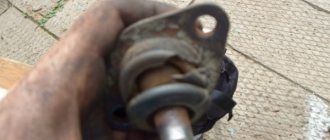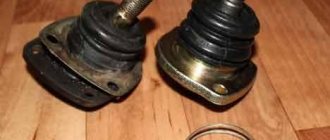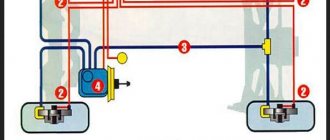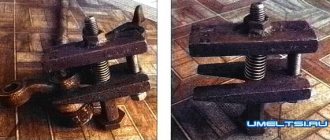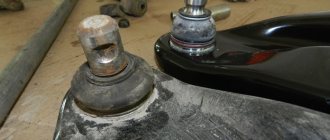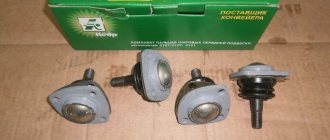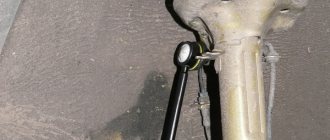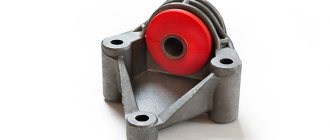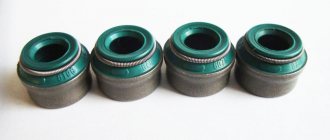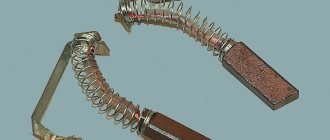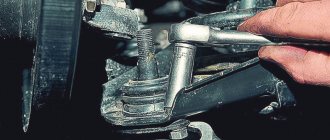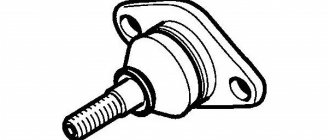Signs of a bad ball joint
Don't know how to determine whether a ball joint is faulty? The answer to this question can be the following situations and their symptoms, presented in the table:
| Symptoms of a bad ball joint | Description of the symptom and cause |
| Knocking from the wheel while driving, especially when driving through potholes and various irregularities. | Clanking and knocking can occur at any speed. It is heard especially well when a loaded vehicle hits a hole, sharply enters a turn with body roll, or sharp braking. It can be either one-time or recurring in nature, during peak load on the ball joint. An exception is the case when the lubricant in the CV joint freezes in the cold season, but after warming up and driving for a short time, it warms up and the knocking stops. |
| Changes in wheel alignment characteristics. | Usually, the wheel on whose side the ball joint is worn out more “suffers” more. Such changes in wheel alignment will not be visible to the eye, so to identify the breakdown, it is recommended to use the services of car services, where they perform wheel alignment measurements and restoration. An indirect sign of a breakdown in this case will be “eating” of the rubber on the edge of the wheel. |
| The car "wobbles" along the road. | This behavior is caused by the appearance of play in the ball joint. Because of it, the wheel wobbles when driving and the car is not able to keep the road straight. Moreover, this yaw will increase as the speed increases. However, at the initial stage, this sign is quite difficult to catch, especially if the car mainly drives on bad (rough, broken) roads. |
| Creak when turning. | In this case, we mean the squeaking noise coming from the front wheels. Since creaking sounds can also come from the power steering or steering rack. Therefore, in this case, it is better to do an additional inspection using a ball assembly. |
| Uneven wear on front tires. | When, as a result of damage to the ball joint, the steering wheel is not strictly vertical, but at an angle to the road surface, then along its inner edge (the one closer to the engine) the tread wears out more than on the rest of the wheel surface. You can simply check this visually by inspecting the corresponding surface of the tire on the side where the knocking occurs while driving. This can also be caused by wheel wobble when driving. |
| During braking, the trajectory of the car changes. | When driving straight and braking, the car may turn slightly to the side. Moreover, the one on the side of which there is a damaged ball joint. This is caused by the fact that one of the wheels is slightly tilted, which creates force for movement. Typically, characteristic clicks are heard coming from the area where the ball joint is installed. As braking increases, the clicking sound may also increase. |
If at least one of the listed signs of malfunction appears, you need to determine the faulty unit, to do this, check not only the ball, but also other suspension elements. Often the problem occurs as a complex, that is, both the ball joint and other elements of the suspension and steering partially fail. And the sooner they are diagnosed and eliminated, the cheaper it will cost and the safer and more comfortable it will be to drive a car.
First signs of breakdown
Exterior view of a car's ball joint
When the car is moving, a slight crunching or light tapping noise is heard - this is the first sign of a malfunction. It is especially noticeable when cornering. Very often, too light a steering wheel or increased play is accompanied by a knocking sound. The main thing is not to confuse it with a broken CV joint, because when the steering wheel is turned all the way at the beginning of movement, they also emit an unpleasant crunch. If you believe the books, then ball joints last forever (provided that they always have lubrication and are operated under normal conditions). Probably, this mode of operation is lying on the counter in a store.
In fact, during operation, the integrity of the anther is compromised. The rubber from which it is made is constantly exposed to dirt and water. Over time, the surface of the boot dries out, it becomes covered with microcracks, which then turn into full-fledged holes. And then small particles fall inside the ball, gradually breaking the metal. As a result, you will hear unpleasant crunching and tapping sounds. In fact, nothing more is needed for the ball to fail; constant exposure to dirt and dust is enough. And the result of such a breakdown is an increase in backlash and the likelihood of jamming. In the latter case, you will not be able to turn the steering wheel, no matter how much force you apply to it.
The initial check of the ball can be carried out practically with bare hands.
Causes of ball failure
There are a number of typical reasons why a ball joint becomes unusable. Among them:
Remember that the causes of ball joint failures do not appear overnight. The only exception may be an initially defective part (for example, with a crack in the body), but the likelihood of this is quite low. Therefore, it is necessary to diagnose the ball at the initial stage of failure. And when buying, it’s also better not to skimp and pay a little more, because the more expensive the part, the more wear-resistant it will be (in most cases). Their main difference is the quality of the material, the type and amount of lubricant used, as well as tensile strength.
Which company should I buy ball joints?
On the Russian market, more than 30 companies offer ball joints for the VAZ 2107 . Of these, the following brands are especially popular:
- "BelMag";
- "Behind the wheel";
- "Track";
- "Cedar";
- "Lemfoerder".
These brands, according to reviews from car service specialists and the results of a customer survey, do not raise any complaints about their quality and are in greatest demand. Units from other companies occupy no more than 5% of the market for this type of spare parts.
How to determine whether a ball joint is faulty
It is believed that the optimal method of checking the ball joint is to visit a car service center where there is a lift and an appropriate stand. There, specialists will be able to identify faults not only with the ball joint, but also with other elements of the vehicle’s suspension.
However, if the task is only to check the ball, then this can be done in garage conditions using just installation. Well, perhaps it would be desirable for the car to be parked on a pit or overpass. A faulty ball joint can be identified by the main symptom - knocking and free movement of the ball pin when a mount force is applied to it.
Quick check
First of all, you need to “listen” to the ball joint. However, for this it is better to take an assistant, preferably one who knows what sound a broken support makes and generally has some understanding of the elements of a car’s suspension. The verification algorithm is simple - one person rocks the car from side to side (in the direction perpendicular to the movement), and the second listens to the sounds coming from the suspension elements, in particular, from the ball joint.
If such rocking does not produce results, it is worth jacking up the car on the side where you want to check the support. Then, holding down the brake pedal (this is done to eliminate possible bearing play), try to swing the wheel in a direction perpendicular to the movement (that is, away from you and towards you). If there is play and/or “unhealthy” clanging sounds, then there are problems with the ball.
Symptoms and causes of element wear
While driving, a worn ball joint manifests itself as follows:
- overcoming small bumps at medium or high speed, you will hear a dull knocking sound coming from the front suspension;
- with average wear, a knock may be heard on the steering wheel;
- In heavily worn bearings, the ball begins to wedge, causing a creaking sound when turning the steering wheel.
If you find one of these signs, you should contact a service station for diagnostics or check the functionality of the parts yourself and without a lift. The service life of ball joints on cars made in Russia, China and Korea is in the range of 20-50 thousand km. Higher quality parts of European and Japanese foreign cars can last up to 150 thousand kilometers. It is necessary to focus on these intervals when troubleshooting .
Contrary to popular belief, the behavior of a car with worn joints when driving on a flat road changes little. The deviation from a straight line and the lateral abrasion of the rubber are so small that an inexperienced driver will not notice the changes, unless the ball joint becomes completely loose. A clear sign is a distinct knocking sound.
Is it possible to drive with a broken ball joint?
Many car enthusiasts who are faced with a similar problem for the first time are interested in the question: if the ball joint is knocking, is it possible to drive with such a breakdown? The answer depends on the degree of wear and damage of the specified unit. If the knocking noise from the ball joint while driving has just appeared and the car is not yet “driving” on the road, it does not knock when turning, that is, there are only early signs, then you can still drive such a car. However, make sure that the driving speed is not high, and also try to avoid potholes and uneven surfaces. And, of course, you still need to think about the upcoming renovation. After all, the sooner it is done, the cheaper it will be, firstly, and secondly, the car can be operated safely!
If the breakdown of the ball joint has already reached such an extent that the car “fidgets” on the road and the knock of the ball joint while driving is clearly audible, then it is better to refuse to operate such a car until repairs are carried out. As a last resort, you can drive it at low speed and following the rules of safe driving to a car service center or garage, where you will have to replace it (usually the ball joint cannot be repaired and is only replaced with a new one).
Source
When is it time to change ball joints?
The reliability of the ball joints is extremely important for safety, so their condition must be carefully monitored and replaced at the first sign of malfunction, which manifests itself in the following:
- knocking noise while driving at low speed;
- creaking when turning the steering wheel, coming from the wheel mounting area;
- unstable course retention;
- uneven tire wear;
You can replace ball joints yourself, without involving car service mechanics.
Diagnostics of ball joints on VAZ 2101-VAZ 2107
Welcome! Ball joints are a very important element of the front suspension, this is especially true for VAZ classic cars. There are twice as many ball joints there as in front-wheel drive cars (4 pieces), due to which the car becomes more dangerous. After all, if you don’t take care and drive a car whose ball joints have failed, the wheel may simply fall on its side. If you drive at this time, the car will immediately lose control and it will be very, very difficult to stop it. We would like to show you a striking example in the video below, where the ball joint fails and the right wheel of the car simply falls on its side.
Note! To diagnose ball joints, you will need a mount or a mounting blade or a crowbar; In addition, you will need a very thin stick, either metal or just a twig, but, very importantly, the stick should be smooth, without bends or the like. (It is best to use a 5.6 cm long metal stick). And besides all this, you will also need a ruler and a small knife. Or instead of a stick, ruler and knife, take a good caliper that will replace all these tools!
Summary:
When is it necessary to diagnose ball joints?
It all depends on the area where the car is used. If you operate it in very large cities (such as Moscow), in the very center of the city, mostly on ideal roads, or in St. Petersburg, where the roads are clearly not inferior, then you don’t even have to bother with diagnosing the suspension. Just look there once a year or every 100,000 km, check everything and move on. But, basically, Lada cars are used in small towns, villages and similar places where the roads, as they say, leave much to be desired. In this case, diagnostics of the entire suspension as a whole, as well as diagnostics of ball joints, should be performed as often as possible, approximately once every 20,000 km. Or after a good collision into a deep hole at speed. This way, you will always be confident in your car and will not be afraid to use it, since after a thorough check you will know with high accuracy that the suspension is fully operational.
Note! Few people adhere to this, because every 20,000 km it is quite expensive to look into the car’s suspension for people who drive almost every day, and these 20,000 km will be covered in a very short period. In this case, diagnostics of ball joints can be carried out immediately after a dull knock appears in the front of the car or when hitting a hole. Usually this sound appears when one of the bearings fails, but until you hear this sound, you will not understand whether the ball joints are working correctly or not. Perhaps these knocks can even be imagined. Therefore, to prevent this from happening and to prevent you from just messing with the car’s suspension, take a close look at the video below, which shows a car with a faulty and noisy ball joint.
How to diagnose ball joints on a VAZ 2101-VAZ 2107?
Note! Ball joints are diagnosed in several ways, the most correct of which is the last (third) method. If you act according to it, you will immediately understand whether the support needs to be replaced or not yet. But there is a big disadvantage in this method, because in order to implement it, you will need to remove the ball joints from the car, and this takes time. Therefore, few people check ball joints for serviceability in this way. On the other hand, if you perform the other two verification methods correctly, they will also give their results. And if the ball joints are very badly damaged, then by checking them in this way, it will also be possible to understand that they are faulty and must be replaced.
labavto.com
The car's ball joint is an important part of the front suspension. This is especially true for classic VAZs, in which there are twice as many of them compared to front-wheel drive ones. If you drive on worn ball joints, then when they fail, the wheel will fall to one side and the car will be in an emergency. Therefore, it is necessary to monitor their condition and replace them on time.
Purpose and design of the part
The ball joint (SHO) of the VAZ 2107 is a hinge that is fixed in the suspension. Thanks to this design, the wheel can only move horizontally and cannot move in the vertical plane. SHOs have a small resource, so their condition needs to be monitored and changed as necessary. Which happens quite often. Damaged anthers must be replaced, as dust, water and dirt penetrate through them, which greatly increases the wear of the balls.
The first cars did not have ball joints; their function was performed by kingpins, requiring constant lubrication. They had insufficient mobility, which made driving difficult. On the VAZ 2107, manufacturers installed SHOs, the body of which contained a spring and a pin. The assembly was protected by a boot on top.
The finger was secured in an eyelet, which was always stationary. The connection was secured by a powerful spring. The entire assembly was covered with a steel boot. This design also required periodic lubrication, but it did not need to be updated as often - twice a year. The pins had to be lubricated once a week.
The designers improved the ball by removing the spring, and replaced the steel boot with a plastic one. The eyelet in which the finger was pressed was made less bulky and refined with a plastic finish. The design became non-separable, which made the ball joints disposable parts.
Why do problems arise with SHOs and what are the symptoms of their failure?
Ball joints may not fully perform their functions during long-term operation for the following reasons:
- Lack of lubrication. The SHO constantly experiences shock loads, which gradually squeeze out the lubricant. When there is a shortage of lubricant, parts rub against each other, which accelerates their wear. In addition, during operation the lubricant loses its characteristics.
- Shock loads. They cause destruction of the pin located in the suspension eye. The knot is designed in such a way that the ball on the pin experiences significant loads. Since the quality of the road surface often leaves much to be desired, the load increases several times.
- Damage to the boot. A boot is installed to protect the hinge joint. It prevents sand, water and dirt from getting onto the support. It is necessary to monitor the condition of the anthers. They are made of rubber, so they are especially susceptible to wear in sub-zero temperatures and hot weather. If cracks, tears or other defects appear on the product, it must be urgently replaced. If this is not done, moisture and abrasive particles from the dirt will get into the hinge and grind down the surface of the pin ball.
- Big gap. With prolonged use, the pin ball gradually wears off, increasing the gap in the steering knuckle, which can lead to loosening of the part. When driving off-road, this can cause your finger to be knocked out of the eyelet.
Signs of wear and tear on the VAZ 2107:
- Wheel rocking. When the car picks up speed, the wheel sways slightly from side to side. The reason is play, which occurs due to wear on the parts of the ball joints. This is dangerous, as a moving car can turn the wheel perpendicular to the body. Therefore, the backlash must be urgently eliminated.
- Suspicious noises and sounds. When driving on a bad road, unpleasant sounds are heard from the side of the wheel: knocking and grinding. They can be heard especially clearly at low speeds – less than 30 km/h. Usually the cause of the noise is a slight break in the ball pin.
- Creaking sound when turning the steering wheel. The reason is a lack of lubrication on one of the ball joints, which becomes unusable
- Uneven wear of rubber on slopes. The reason may be a malfunction of the ball joints or other problems associated with the wheels.
If the listed symptoms appear, you need to check the SHO.
Diagnostics of ball joints
The frequency of diagnostics depends on the area in which the vehicle is operated. In large cities with good roads, checking can be done after 100 thousand kilometers. In rural areas where there are no roads, it is advisable to check the suspension and ball joints as often as possible, at least after 20 thousand km. You can check the SHO in several ways:
- Aurally. The engine stalls. The driver and assistant rock the car by pressing on the hood on both sides. If you hear a suspicious sound from one of the wheels, then there may be a problem with the corresponding wheel drive. It will either need to be replaced or lubricated.
- Checking ball pins. The method is applicable only for the latest releases of “sevens”, which are equipped with special holes that allow you to control the wear of the product through them, without resorting to disassembling the support. If the pin is worn by more than 6 mm, the SHO must be replaced.
- Determination of play of ball joints. To do this, the wheel on which there is a suspicion of a failed wheel brake is raised by 30 cm using a jack. The assistant in the cab presses the gas pedal all the way. Then you need to grab the upper edge of the wheel with one hand, and the lower edge with the other, and forcefully swing it up and down. Then do the same in the horizontal plane, swinging the wheel left and right. When the brakes are locked, the presence of play will immediately become apparent. Even with minimal play, the ball needs to be replaced.
Self-replacement: step-by-step instructions
The main part of the ball joint, on the quality of which the service life of the entire hinge joint depends, is the ball pin. It must be made of high-alloy steel, its ball must undergo a cementation procedure so that its surface becomes more durable, and its body is hardened. The technology for manufacturing high-quality SHOs requires large material costs. Therefore, only a few companies can afford it for the manufacture of ball joints for the VAZ 2107. Among them:
Italian made Pilenga
Belebeevsky
When purchasing kits, you should be wary of counterfeits, so you should buy from trusted sellers or specialized stores. It's not worth saving. High-quality products always cost more.
The first VAZ 2107 models used collapsible ball joints. Therefore, they could be disassembled and worn parts replaced. In the latest “seven” SHOs they install non-separable products.
For the replacement procedure you need to prepare:
- jack;
- new repair kit;
- puller for squeezing out the support;
- hammer;
- screwdriver;
- a set of keys.
The replacement process is a sequence of steps:
- Using a jack, we raise the car and remove the wheel on which we will change the support.
- We take the key at “22” and unscrew the nut that secures the pin in the upper steering knuckle.
- Using a puller, squeeze the pin out of the steering knuckle. You can use a hammer and hit the pendant several times. At this time, pry the part to be removed with a long lever and pull it up.
- Next, we unscrew the three bolts with a “13” key, thanks to which the upper SHO is held on the lever and take it out along with the cover and plate. Let's check her condition. If the finger moves freely, without effort, the support must be replaced.
- Using a wrench set to “22”, loosen the fastening nut of the lower SHO. Extrude the lower finger in the same way as the top one. Now there is nothing stopping you from completely unscrewing the nut.
- Unscrew the fastening nut holding the ball pin. Then we unscrew the three bolts securing the SHO to the lever. We take out the ball joints. We replace it with new parts, after applying a little lubricant under the boot.
- We assemble the suspension in the reverse order of disassembly.
Technically, replacing the SHO with a VAZ 2107 is not difficult. The only difficulty that arises is in pressing the ball pins out of the steering knuckle; considerable physical effort must be made. Therefore, it is advisable to be in good physical shape. Otherwise, the replacement is not difficult.
Gaps in the upper hinges of VAZ 2101-2107
To independently diagnose the condition of ball joints, you will need a special device for measuring play and a torque wrench.
The diagnostic procedure looks like this:
The sum of the readings should not be more than 0.8 mm. If it differs from this value, then the ball joint needs to be replaced. Driving with a broken one is not only uncomfortable, but also dangerous - at any moment your finger can be torn out of the clip. And if this happens at high speed, a fatal outcome cannot be avoided.
Diagnostics of the lower ball
And now about how to check the ball joint located on the lower arm on a VAZ. To do this you will need to perform several steps:
If diagnostics show that replacing the ball joint is not required, drive some grease inside. To do this, you can even use a simple syringe installed in the hole in the lower part of the clip. It is advisable to use Litol-24 type lubricant. It can also be driven under the boot.
Functionality check
Every car enthusiast should know the basic methods for diagnosing ball joints. The main ones are:
| Aurally | The simplest diagnostic option. Diagnostics is carried out by two people - one rocks the car with the engine turned off, the second listens for the presence or absence of squeaks or knocks from the wheels (if any, replacement is inevitable) |
| Presence of play | One of the wheels needs to be jacked up. The partner must get into the car and press the brake pedal all the way. The second partner must swing the wheel vertically and horizontally. If there is play, it immediately manifests itself in this way, which indicates the replacement of the ball joint |
| Finger wear | In the latest models of the “six”, supports were installed with special diagnostic holes, using which you can independently determine the wear of the pin. If wear of 7 mm or more is detected, replacement is required. |
Everyone decides for themselves how to check the ball joints on a VAZ 2106.
Replacing the lower supports
After checking the ball 2107 and making sure that it is broken, you need to unscrew the bolt from the pin. But you won’t be able to unscrew it completely; first, make a few turns. Further actions:
Before installing new elements, it is necessary to fill a sufficient amount of lubricant under the boot. Be sure to check the integrity of the rubber boots.
Ball joints are the most short-lived parts of the AvtoVAZ classic suspension.
Considering the state of domestic roads, the ball joint on a VAZ 2107 is the first part that has to be changed after a certain mileage of the car. Novice car enthusiasts have questions about how to replace ball joints and which ball joints are best to install on a VAZ 2107 .
Preparing for replacement
After you have checked the ball joints on the VAZ and found that they are damaged, be sure to replace them. During the preparation phase, you will need to complete the following steps:
- Place a jack under the side of the car that is being repaired.
- Place wheel chocks under the rear wheels.
- Loosen the bolts on the wheels, then lift the side of the car. Remove the wheel and place it under the bottom of the engine.
That's it, the preparation is over. Now it is necessary to dismantle the old ball joints and install new ones.
Design and purpose of ball joints
The design of the front suspension with ball joints replaced the previously popular pivot mechanism and is the most common. The task of these units is to ensure vertical movement and rotation of the wheel while driving. Ball joints are constantly subject to strong variable loads while the vehicle is moving, and their failure can lead to a serious accident. Therefore, special requirements are placed on the material and quality of manufacture of ball joints. The rapid wear of the balls during operation even forced designers to develop suspension options without this “delicate” unit. But, as mentioned above, most cars (and the entire VAZ line of cars) include ball joints in the front suspension design.
“Ball” (as they are called for short) are manufactured in two versions: cast-in-place designs and products with a metal-ceramic liner. The first type is used in the upper, the second - in the lower ball joints. This is due to the different loads to which the liners are exposed. In the lower nodes, compression and tension alternately occur, in the upper nodes only compression occurs.
